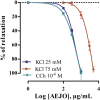Antispasmodic and antidiarrheal effects of Juniperus oxycedrus L. on the jejunum in rodents
- PMID: 38777767
- PMCID: PMC11109480
- DOI: 10.1540/jsmr.60.10
Antispasmodic and antidiarrheal effects of Juniperus oxycedrus L. on the jejunum in rodents
Abstract
Functional bowel disorders (FBD) have a major potential to degrade the standards of public life. Juniperus oxycedrus L. (J. oxycedrus) (Cupressaceae) has been described as a plant used in traditional medicine as an antidiarrheal medication. The present study is the first to obtain information on the antispasmodic and antidiarrheic effects of J. oxycedrus aqueous extract through in vitro and in vivo studies. An aqueous extract of J. oxycedrus (AEJO) was extracted by decoctioning air-dried aerial sections of the plant. Antispasmodic activity was tested in an isolated jejunum segment of rats exposed to cumulative doses of drogue extract. The antidiarrheic activity was tested using diarrhea caused by castor oil, a transit study of the small intestine, and castor oil-induced enteropooling assays in mice. In the jejunum of rats, the AEJO (0.1, 0.3 and 1 mg/ml) diminished the maximum tone induced by low K+ (25 mM), while it exhibited a weak inhibitory effect on high K+ (75 mM) with an IC50=0.49 ± 0.01 mg/ml and IC50=2.65 ± 0.16 mg/ml, respectively. In the contractions induced by CCh (10-6 M), AEJO diminished the maximum tone, similar to that induced by low K+ (25 mM). with an IC50=0.45 ± 0.02 mg/ml. The inhibitory effect of AEJO on low K+ induced contractions was significantly diminished in the presence of glibenclamide (GB) (0.3 µM) and 4-aminopyrimidine (4-AP) (100 µM), with IC50 values of 1.84 ± 0.09 mg/ml. and 1.63 ± 0.16 mg/ml, respectively). The demonstrated inhibitory effect was similar to that produced by a non-competitive antagonist acting on cholinergic receptors and calcium channels. In castor oil-induced diarrhea in mice, AEJO (100, 200, and 400 mg/kg) caused an extension of the latency time, a reduced defecation frequency, and a decrease in the amount of wet feces compared to the untreated group (distilled water). Moreover, it showed a significant anti-motility effect and reduced the amount of fluid accumulated in the intestinal lumen at all tested doses. These findings support the conventional use of Juniperus oxycedrus L. as a remedy for gastrointestinal diseases.
Keywords: Juniperus oxycedrus; antidiarrheic; antispasmodic; aqueous extract; functional bowel disorders.
Conflict of interest statement
The authors declare no conflicts of interest.
Figures





Similar articles
-
Anti-diarrhoeal activity of methanol extract of Santalum album L. in mice and gastrointestinal effect on the contraction of isolated jejunum in rats.J Ethnopharmacol. 2014 Jul 3;154(3):704-10. doi: 10.1016/j.jep.2014.04.043. Epub 2014 May 6. J Ethnopharmacol. 2014. PMID: 24809287
-
Freeze dried extracts of Bidens biternata (Lour.) Merr. and Sheriff. show significant antidiarrheal activity in in-vivo models of diarrhea.J Ethnopharmacol. 2016 Dec 4;193:416-422. doi: 10.1016/j.jep.2016.09.041. Epub 2016 Sep 21. J Ethnopharmacol. 2016. PMID: 27664442
-
Antidiarrheal activity of Pyrenacantha staudtii Engl. (Icacinaceae) aqueous leaf extract in rodents.J Ethnopharmacol. 2011 Sep 1;137(1):148-53. doi: 10.1016/j.jep.2011.04.068. Epub 2011 May 6. J Ethnopharmacol. 2011. PMID: 21571058
-
Investigations of plausible pharmacodynamics supporting the antispasmodic, bronchodilator, and antidiarrheal activities of Berberis lycium Royle. Via in silico, in vitro, and in vivo studies.J Ethnopharmacol. 2023 Apr 6;305:116115. doi: 10.1016/j.jep.2022.116115. Epub 2022 Dec 29. J Ethnopharmacol. 2023. PMID: 36587881
-
Final report on the safety assessment of Juniperus communis Extract, Juniperus oxycedrus Extract, Juniperus oxycedrus Tar, Juniperus phoenicea extract, and Juniperus virginiana Extract.Int J Toxicol. 2001;20 Suppl 2:41-56. doi: 10.1080/10915810160233758. Int J Toxicol. 2001. PMID: 11558640 Review.
References
-
- Ducrotté P. Pathophysiology and treatment of functional bowel disorders. EMC - Hépato-Gastroenterologie. 2005; 2(4): 400–12.
-
- Marx M, Maye H, Abdelrahman K, Hessler R, Moschouri E, Aslan N, et al. [Functional gastrointestinal disorders: update on the Rome IV criteria]. Rev Med Suisse. 2018; 14(616): 1512–6 (in French). - PubMed
-
- Ekaghba ELM, Bignoumba PEI, Bourobou JAB, Mounanga MMB. Etude épidémiologique des troubles fonctionnels intestinaux dans les structures sanitaires à Libreville (Gabon). J Appl Biosci. 2020; 155(1): 15986–91.
-
- Semerdjieva I, Zheljazkov VD, Radoukova T, Radanović D, Marković T, Dincheva I, et al. Essential oil yield, composition, bioactivity and leaf morphology of Juniperus oxycedrus L. from Bulgaria and Serbia. Biochem Syst Ecol. 2019; 84(2): 55–63. doi: 10.1016/j.bse.2019.04.001 - DOI

